Effects of New Asphalt Overlay on Decreasing Urban Accidents
MOHAMMAD KARI1 and MANSOUR FAKHRI22 *
1
Department Of Civil Engineering, South Tehran Branch,
Islamic Azad University,
Tehran,
Iran
2
Department Of Civil Engineering,
Khaje Nasir Toosi University,
Tehran,
Iran
DOI: http://dx.doi.org/10.12944/CWE.10.Special-Issue1.63
It has been well proven that as the friction of a road surfacing decreases, the number of crashes increases, causing road death and injuries. In this research tried to study on the effect of the friction between road surface and tires on the accidents by rebuilding asphalt overlay. That has been studied in this article by studying on the information about traffic, accidents and case study concerning a street in Tehran by execution the new asphalt overlay. In order to survey the influence of execution of the new asphalt overlay, all the information about traffic volume and accidents in the said street gathered and investigated. Furthermore the result from each part compared with other researches. Results have shown that number of accidents decreased sensibly by modifying asphalt overlay and this decrease would be more at higher speeds. Therefore the method of modifying asphalt overlay is recommended in risky points to preventing or decreasing the accidents.
Copy the following to cite this article:
Fakhri M, Kari M. Effects of New Asphalt Overlay on Decreasing Urban Accidents. Special Issue of Curr World Environ 2015;10(Special Issue May 2015). DOI:http://dx.doi.org/10.12944/CWE.10.Special-Issue1.63
Copy the following to cite this URL:
Fakhri M, Kari M. Effects of New Asphalt Overlay on Decreasing Urban Accidents. Special Issue of Curr World Environ 2015;10(Special Issue May 2015). Available from: http://www.cwejournal.org/?p=10779
Download article (pdf)
Citation Manager
Publish History
Select type of program for download
| Endnote EndNote format (Mac & Win) | |
| Reference Manager Ris format (Win only) | |
| Procite Ris format (Win only) | |
| Medlars Format | |
| RefWorks Format RefWorks format (Mac & Win) | |
| BibTex Format BibTex format (Mac & Win) |
Article Publishing History
| Received: | 2015-03-15 |
|---|---|
| Accepted: | 2015-03-26 |
Introduction
By daily increase in the number of vehicles in the world and the necessity of providing traffic facilities, as well as increasing in vehicles' speeds, the issue of preparing standards both for the vehicles braking system and road pavements has been in consideration. Nowadays the most developed countries have provided codes of practice and implemented them. Considering intercity and rural roads in areas like intersections, curves, etc., the greater the friction coefficient of road overlays, the less is road accidents. One of these crash factors, is the road factor, which includes two parts: one is the road condition from a geometrical point of view comprising road slope, curves and their slopes, and intersections and the other is road system deficiencies, like skid roads, traffic sign deficiencies, low-width roads, lack of side shoulders, presence of elevation difference at the road surface, lack of side guard-rails and visibility issues. Among these, the friction between tire and surface of the pavement is of significant importance, and without adequate friction coefficient, crashes due to skidding are inevitable (Kavoosi et al., 1995). Skid-pavements are the cause of many probable crash incidents. Principally, skidding happens when the friction factor between tires and the pavement is not adequate to keep the adhesion between them. The issue of skidding should not be considered as a separate issue, but to avoid this problem, it is necessary to optimize both the characteristics of a tire and the road. This is done to reduce the risk of skidding. One of major factors in providing vehicles safety, is to increase the surface friction of road pavement. Up-to now there have been not enough and distinct statistics concerning the impact due to lack of friction resistance of Iran's roads. While in England, where extensive studies have been done on the effect of friction resistance on crash events, it has been shown that more than one-fourth of crashes in this country are the result of skid conditions. Also these figures are true concerning Greece (Kokkalis et al., 1998).The results of this research could be used in finding methods for maintaining roads safety and prioritizing asphalt pavement operations.
Research Background
Road surface friction is a major statistical index for difference in crash rates in different roads, So that rates of road crashes increase with decline in friction value, and the ratio of crash occurrence declines with increasing in average traffic volume (Ahadi et al., 2012). And Studies have found a U-shaped relationship between vehicle speed and crash incidence (Kuttesch et al., 2004). In an investigation in order to maximize surface friction for improvement of roads safety, crash data for a period of 10 years related to 6 study regions have been analyzed and the results have exhibited no relationship between number of crashes and road friction. Although some evidences showed that, with decrease in surface friction, number of crashes increases with increased road life. But the frequency of these crashes is not adequate for this claim (Noyce et al., 2007). Therefore surface friction in fact is a factor that impacts the number of crashes and enhances safety and better control of the vehicle (Nasir Ahmadi et al., 2011). Decrease in surface friction, changes proportionally with increase in some special type of crashes, but there are little information concerning the way it affects the type of accident. Data obtained from 5 years before and after replacement of pavements, with the aim of assessing various types of crashes occurred in Australia, indicates overall decrease in the number of crashes (39%) in a 5 years period and rear-end crashes comprise a great number of road accidents. Although with new asphalt overlays, the overall number of crashes decreases, but the proportion of different types remains the same, which indicates that number of crashes should be accounted as a more important factor than their type (Cassandra et al., 2008).
Methodology
This study has been accomplished as a practical investigation and the procedure of statistical data gathering and field study have been used .In this investigation, through surveying statistical data including traffic, crashes and case study of a street with considerable traffic volume, in Tehran, asphalt pavement is implemented. One factor that affects decrease of crashes and enhancement of road safety is the increase of friction between contact areas of vehicle’s tire with the surface pavement, this purpose is accomplished by implementing asphalt pavement for the study area and increase of surface friction. Information and statistics of crashes are provided by Police and concerning the number of incidents due to skidding, survey has been done by investigation in the causes of crashes. Traffic volume statistics of the study area is prepared. Ultimately by surveying changes in crashes statistics, related to the surface pavement friction, the impact of implementation of asphalt pavement on the crash reduction, have been shown and compared with results of previous studies.
Results and Discussions
Several studies have shown that surface road friction is related to the traffic rate and life of the pavement (Shafeipoor et al., 2013). For this reason the traffic volume statistics for the study area, which has relatively high traffic volume, is of great importance. Traffic volume in time intervals of 15 minutes, have been counted and surveyed by the number of light vehicles, heavy vehicles, motorcycles and bicycles separately and finally made equivalent to passenger cars. The maximum traffic volume at the peak traffic flow at morning is between 7:15 to 8:15 and the equivalent passenger vehicle number is about 3200 at the peak hour. These results are shown in Table 1.
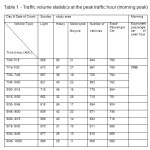 |
Table1: Traffic volume statistics at the peak traffic hour (morning peak) Click here to View table |
Traffic volume counts of the study area, indicates that the average traffic number is about 3200 vehicle per hour in the peak traffic hour. About 20% of the total vehicles are heavy vehicles and this percentage is taken constant during the study. Also results given by Haddock et al. have revealed that the average traffic number has greater impact on the surface friction of the pavement, compared to other traffic statistics (Haddock et al., 2009).
The number of crashes in study area for the years before and after implementation of asphalt pavement and the changes in percentages are shown In Table 2 and Figure 1.
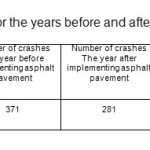 |
Table2: Crash statistics for the years before and after pavement implementation |
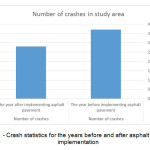 |
Figure1: Crash statistics for the years before and after asphalt pavement implementation |
By investigation in the statistical reports provided by police for the study area it is clear that 50% of crashes are related to break system functionality and the friction resistance for the rear-end type crashes. In the referred statistics by police the causes: not maintaining safe following distance, not maintaining right of way and inability to control the vehicle have been mentioned and are presented here in Table 3.
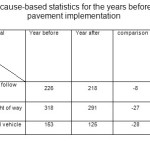 |
Table3: Crashes cause-based statistics for the years before and after asphalt pavement implementation |
Based on Cassandra et al. research, Although number of crashes have declined since using new asphalt pavement but the proportion of different types of them remain the same, which indicates that total number of crashes should be given more importance than the type of crashes (Cassandra et al., 2008). As is seen in Table 3, the traffic statistics related to surface friction of pavements have declined which indicates the effect of surface friction asphalt improvement on decrease in the number of crashes. Results of Table 2. And Figure 1 show that crashes have declined in study area by 24% after modification by implementing asphalt pavement. Also research done by Green et al. Showed that after 12 months of surface pavement repairs, crash occurrence risk is similar to or smaller than before implementing the repair. In the first months after implementation of new asphalt pavements, a small but very important increase is seen in accidents risks (Green et al., 2008) which are comparable with results obtained from this research.
In Table 4. And Figure 2, Crash events statistics are shown based on their occurrence hour, which indicates that most of incidents taken place are related peak noon and afternoon hours, despite that there is no significant increase in crash incidences during peak morning traffic which is related to the surface pavement temperature. As by increasing temperature of surface pavement we observe decrease in surface friction of the pavement, therefore tangible increase in crash statistics from 10 Am to 8 pm, could explain this claim. Too decrease of crashes at noon, after modification of street pavement and considering provided explanations, indicate the impact of increase in pavement friction resistance on decrease of our case study street crashes.
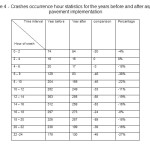 |
Table4: Crashes occurrence hour statistics for the years before and after asphalt pavement implementation Click here to View table |
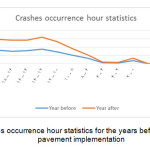 |
Figure2: Crashes occurrence hour statistics for the years before and after asphalt pavement implementation |
Finally it can be concluded that by increase in the number of vehicles in rush hour, crashes increase in number. Increase in pavement surface friction due to implementing new asphalt pavement causes overall decline of crashes. Based on Kuttesch et al. research, crash occurrence decreases with increase in traffic volume (Kuttesch et al., 2004). Research done by Fakharian et al. showed that by increase in the vehicle speed, crashes increase in number (Fakharian et al., 2012). Therefore increase in pavement surface friction by implementing new asphalt pavement, respecting percentages of crash decline shown in Figure 2, and at hours where volume traffic is small and vehicles speed is high, have greater decreasing impact on crash occurrences.
Conclusions
In this research the following results have been obtained:
- Number of crashes declines for the year after implementing asphalt pavement at a 24 percent rate, compared with the year before it.
- Number of crashes due to surface pavement friction is about 50% of total number of occurred crashes.
- Crashes due to inability to control vehicle, show greater decrease after modification of pavement surface friction.
- Implementing asphalt pavement does not result in tangible change in the causes of crash events.
- Most daily crashes, take place at daily peak traffic hours.
- By increasing number of street crashes, especially those related to the brake system performance and pavement friction, the solution is to consider rehabilitation of asphalt pavement.
- In non-rush hours in which speed of vehicles and the rate of incidents are both high, the factor of surface friction have more significant decreasing effect on the number of crashes.
References
- Ahadi, M.; Shafeipoor, A. Effect of skidding resistance of asphalt overlays on road crashes, Journal of Rahvar Police, 18, 1-16(2012).
- Cassandra, S. Performance of High Skid Resistance Surface Crash Trends. International Safer Roads Conference, 2nd, Cheltenham, United Kingdom (2008).
- Fakharian, S.; Moghadass Nejhad, F. Descriptive model of total number of vehicle crashes in rural roads of Iran and determination of cause-of-crashes weight. 11th international Conference on Traffic and Transportation Engineering. March 5, Tehran (2012).
- Green, M. J.; Caudwell, L. Early life skid resistance – an assessment of accident risk (Transport Research Laboratory, 2008).
- Haddock, E.; O'Brien, J.; Patricia, J. Frictional Resistance of Aggregates for Hot-Mix Asphalt Pavements (Indiana Department of Transportation and Federal Highway Administration, 2009).
- Kavoosi, A. friction coefficient needed for surface pavement. Road and geotechnical specialty training course, Elmo-Sanat University and Technical and Soil Mechanics Laboratory, 4, (1995).
- Kokkalis, A. G.; Panagouli, O. K. Fractal Evaluation of Pavement Skid Resistance Variations. I: Surface Wetting. Chaos, Solitons & Fractals, 9(11), 1875–1890(1998).
- Kuttesch, S. j. Quantifying the Relationship between Skid Resistance and Wet Weather Accidents for Virginia Data (Virginia Polytechnic Institute and State University, 2004).
- Nasir Ahmadi, K. Effect of pavement texture in controlling skidding and road crashes reduction (Islamic Azad University South Tehran Branch, 2011).
- Noyce, D. A.; Bahia, H. U.; Yambo, J.; Chapman, J.; Bill, A. incorporating road safety into pavement management: maximizing surface friction for road safety improvements, (Midwest University Transportation Center and Wisconsin Department of Transportation, 2007).
- Shafeipoor, A. Proper arrangement of pavement aggregates for improvement of friction resistance of asphalt overlays (Elmo-Sanat University, 2013).






